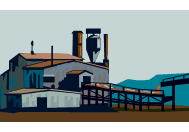vol. 5 A Surprise in the Trade Show
- We Can’t Go Back To Our Office!
One evening, five members of the Department of Development of Company X visited our office with a grave look on their faces. The leader of the team told us, “We can’t go back to our office.” Wait a minute now — we’re a patent office, what do we have to do with whether you can go back to your office or not?

No Way!
In fact, these five persons were members of a project. They were selected to develop a new device and the team included some Doctors of Engineering who had worked on the research for 10 months. ?Around the time they completed their project, a large trade show for their industry was being held. The team, full of confidence, walked into the big venue to check out the competition. They made a round without encountering any surprises. Then, they were about to take a break when a device caught their eyes. As they took a closer look at the device, they realized that it looked similar to the one the team had developed. Oh no! No way! Everyone on the team asked questions of the exhibitor, and as it turned out, the device had a similar structure to theirs. ?They were upset but kept asking questions. “Have you filed an application for a patent?” they asked, and the exhibitor responded, “Of course, we have already filed an application.”

- One 100 Million Yens Wasted?
There are many types of development projects. Some can be developed on the table of a small workshop, while others are the result of repeating large-scale tests in outdoor facilities. The development project of the team fell into the latter category. They assembled and disassembled one large device after another to repeat tests. ?As a result, investment in the projected equaled 100 million yens, including the employees’ salaries. If the finished product was to be blocked by the patent rights of the other company, all efforts would go down the drain. That is why they could not go back to their office…they could not go back to their office to tell their boss: “After all those investments, we won’t be able to produce our device.” After such a huge failure, they were afraid they might be demoted or, even worse, fired. ? Unsure of what to do, they came to our office to consult us about their patent issues.

What shall we do? I thought to myself, since our clients say they can’t go back, what are we, as a patent office, supposed to start with? They said their competitor had already filed an application for a patent. Well then, first, let’s check the details of their application, then we can think about countermeasures. So, I told the team members. “Please go back to your office today but don’t tell your boss?about what happened during the trade show. We will come up with countermeasures by the end of tomorrow.” Reluctantly, they left our office feeling very uneasy. At that moment, I didn’t have any good ideas. Still, I immediately went on to search for the patent application with the name of the competitor and the key words of the invention. With relative ease, I located the publication before examination of the patent application. (“Publication before examination of a patent application” is a document that publishes an invention 18 months after the date of the patent application, whether or not the patent has actually been granted.)
Now we found the publication before examination of the patent application. Will it bring about good luck or bad luck?
- After Reading the Publication
As I read the publication, I saw that it described a device almost exactly the same as the one the team members explained to us the day before. However, I noticed that there might be some problems. ?The problems I noticed were just a layman’s observations – I wondered if one of the parts was going to work. ?Next afternoon, the project team members came back to our office with anxiety written all over their faces. ?First of all, I showed them the patent application publication. All of them looked astonished. ?After waiting for them to calm down, I asked them, “Are there any problems with this part here? Isn’t it hard to use when it’s wet? Shouldn’t that part be different?” All of a sudden, everybody started talking quickly, and they immediately came up with several ideas for improvement. ?Then I told them, “Let’s file an application to patent these improvements. Your invention will be granted a patent if we specify that you knew about your competitor’s application, but their invention had a problem. This is the technology that solves the problem. Besides, you can report to your boss the same thing: that you completed an invention that solves the issues with the competitor’s invention. I am sure you won’t be demoted but, instead, promoted.” All of them went back to their office with beaming smiles.

Before they left our office, I gave them a word of advice: please make sure to conduct patent research before starting and during the development of a new product. If you need help in researching patents, our office will be happy to conduct the research for you.
